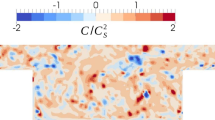Abstract
A numerical microscale model of aerodynamics and the transport of pollution was developed. The model takes into account the nonhomogeneity of elements of the urban boundary layer. The numerical solution of the differential problem is based on the finite volume method. On the basis of experiments, a comparison of three different turbulent closure schemes and parameterizations of the urban vegetation was conducted. Turbulent air dynamics and the transport of pollution were modeled around an array of buildings.
Similar content being viewed by others
References
R. B. Nuterman, A. V. Starchenko, and A. A. Baklanov, “Development and Analysis of Microscale Meteorological Model for Researching the Air Mass Flows in the Urban,” Vychislit. Tekhnol. 13(3), 37–43 (2008).
P. Louka, M. Ketzel, P. Sahm, E. Guilloteau, N. Moussioroulos, J.-F. Sini, R.G. Mestauer, and R. Verkowiez, “SFD Intercomparison Exercise Within TRAROS European Research Network,” in Proc. 7th Int. Conf. on Environmental Science and Technology (Syros, 2001), Available from http://www2.dmu.dk/atmosphericenvi-ronment/Trapos/Downloads/7CEST-TRAPOS.pdf
J. Ehrhard, R. Kunz, and N. Moussiopoulos, “On the Performance and Applicability of Nonlinear Two-Equation Turbulence Models for Urban Air Quality Modeling,” Environ. Monit. Assess. 65, 201–209 (2000).
G. G. Katul, L. Mahrt, D. Poggy, and C. Sanz, “One- and Two-Equation Models for Canopy Turbulence,” Boundary-Layer Meteorol. 113, 81–109 (2004).
J. D. Wilson and R. H. Shaw, “A Higher-Order Closure Model for Canopy Flow,” J. Appl. Meteorol. 16, 1198–1205 (1977).
K. W. Ayotte, J. J. Finnigan, and M. R. Raupach, “A Second-Order Closure for Neutrally Stratified Vegetative Canopy Flows,” Boundary-Layer Meteorol. 90, 189–216 (1999).
J. Katolicky and M. Jicha, “Eulerian-Lagrangian Model for Traffic Dynamics and Its Impact on Operational Ventilation of Road Tunnels,” J. Wind Eng. Industr. Aerodynam. 93, 61–77 (2005).
D. Bäumer, B. Vogel, and F. Fiedler, “A New Parameterisation of Motorway-Induced Turbulence and Its Application in a Numerical Model,” Atmos. Environ. 39, No. 31, 5750–5759 (2005).
E. Yee and C. A. Biltoft, “Concentration Fluctuation Measurements in a Plume Dispersing through a Regular Array of Obstacles,” Boundary-Layer Meteorol. 111, 363–415 (2004).
M. W. Rotach, R. Vogt, C. Bernhofer, E. Batchvarova, A. Christen, A. Clappier, B. Feddersen, S.-E. Gryning, G. Martucci, H. Mayer, V. Mitev, T. R. Oke, E. Parlow, H. Richner, M. Roth, Y.-A. Roulet, D. Ruffieux, J.A. Salmond, M. Schatzmann, and J. A. Voogt, “BUBBLE an Urban Boundary Layer Meteorology Project,” Theor. Appl. Climatol. 81, Nos. 3–4, 231–261 (2005).
L. G. Loitsyanskii, Fluid Mechanics: Student’s Book for High School, 7th ed. (Drofa, Moscow, 2003) [in Russian].
B. E. Launder and D. B. Spalding, “The Numerical Computation of Turbulent Flows,” Comput. Meth. Appl. Mech. Eng. 3, No. 2, 269–289 (1974).
T. J. Craft, B. E. Launder, and K. Suga, “Development and Application of a Cubic Eddy Viscosity Model of Turbulence,” Int. J. Heat Fluid Flow 17, 108–115 (1996).
B. E. Launder, “Second-Moment Closure and Its Use in Modeling Turbulent Industrial Flows,” Int. J. Num. Meth. Fluids 9, 963–985 (1989).
F. S. Lien and M. A. Leschziner, “Assessment of Turbulent Transport Models Including Non-Linear RNG Eddy-Viscosity Formulation and Second-Moment Closure,” Comput. Fluids 23, No. 8, 983–1004 (1994).
R. Louka, Contribution of Retroula Louka to the TRAROS WG-TRT Meeting in Cambridge (2000), Available from http://www2.dmu.dk/Atmosrheris-Environment/traros/texte/louka-samb.pdf
C. C. Chieng and B. E. Launder, “On the Calculation of Turbulent Heat Transport Downstream from an Abrupt Pipe Expansion,” Num. Heat Transfer 3, 189–207 (1980).
S. Patankar, Numerical Heat Transfer and Fluid Flow (Hemisphere Pub., 1980; Energoatomizdat, Moscow, 1984).
A. A. Samarskii and P. N. Vabishchevich, Numerical Methods for Solving the Convection-Diffusion Problems (Editorial URSS, Moscow, 1999) [in Russian].
P. N. Vabishchevich, Methods of Fictitious Areas in Mathematical Physics Problems (Mosk. Gos. Univ., Moscow, 1991) [in Russian].
B. Van Leer, “Towards the Ultimate Conservative Difference Scheme. II. Monotonicity and Conservation Combined in a Second Order Scheme,” J. Comput. Phys. 14, 361–370 (1974).
V. P. Il’in, Methods of Incomplete Factorization for Solving the Algebraic Systems (Fizmatlit, Moscow, 1995) [in Russian].
Turbulent Shear Flows, Ed. by A. S. Ginevskii (Mashinostroenie, Moscow, 1982), Vol. 1.
A. Kimura, T. Iwata, A. Mochida, H. Yoshino, R. Ooka, and S. Yoshida, “Optimization of Plant Canopy Model for Reproducing Aerodynamic Effects of Trees: (Part 1) Comparison between the Canopy Model Optimized by the Present Authors and That Proposed by Green,” Summ. Tech. Pap. Ann. Meeting Architect. Inst. Jpn. 9, 721, 722 (2003).
M. Ketzel, R. Berkowiez, and A. Lohmeyer, “Comparison of Numerical Street Dispersion Models with Results from Wind Tunnel and Field Measurements,” Environ. Monit. Assess. 65, 363–370 (2000).
J. Eichhorn, MISKAM-Handbuch zur Version 3.xx, (Giese-Eichhorn, Wackernheim, Oct. 1998).
R. Berkowiez, “OSPM: A Parameterized Street Pollution Model,” Environ. Monit. Assess. 65, 323–331 (2000).
Author information
Authors and Affiliations
Corresponding author
Additional information
Original Russian Text © R.B. Nuterman, A.A. Baklanov, A.V. Starchenko, 2010, published in Matematicheskoe Modelirovanie, 2010, Vol. 22, No. 4, pp. 3–22.
Rights and permissions
About this article
Cite this article
Nuterman, R.B., Baklanov, A.A. & Starchenko, A.V. Modeling of aerodynamics and pollution dispersion from traffic in the urban sublayer. Math Models Comput Simul 2, 738–752 (2010). https://doi.org/10.1134/S2070048210060098
Received:
Published:
Issue Date:
DOI: https://doi.org/10.1134/S2070048210060098



